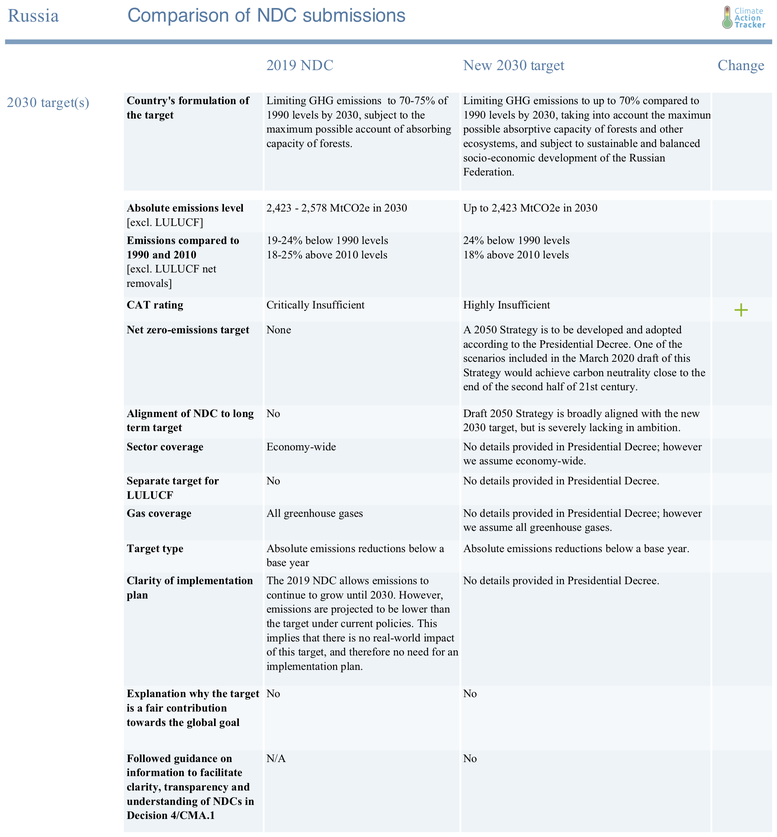CAT Climate Target Update Tracker
Russian Federation
Summary
Russia adopts new 2030 target
Russia adopted a new 2030 target in November 2020. The update did not strengthen the country’s 2030 target in any real sense as it is higher than Russia’s own 2030 emissions projections under current policies. The CAT rates the ‘new’ target as ‘Highly Insufficient’.
Scroll down for a detailed analysis of Russia’s new target or click the button to view the latest CAT assessment for Russia.
CAT analysis


On 4 November 2020, Russian President Vladimir Putin signed a Presidential Decree adopting a 2030 target of at least 30% below 1990 levels, taking into account the maximum possible absorptive capacity of forests. This document is only available in Russian. The CAT analysis is based on a translation of this Decree.
We interpret the reference to the maximum absorptive capacity of forests to mean that Russia intends to include land use, land use change and forestry (LULUCF) sinks in both its base and target years. The Presidential Decree does not refer to any LULUCF projections for 2030; however, we assume that it will be the same as that used in Russia’s draft long-term strategy released early this year. The Presidential Decree provides little detail of the nature of the target. We have assumed that Russia will continue with the same sector and gas coverage as its previous target.
Russia’s ‘new’ target falls just inside of the ‘Highly Insufficient’ range. A reduction of at least 30% below 1990 levels (incl. LULUCF) corresponds to an emissions limit of up to 2.4 GtCO2e in 2030 (excluding LULUCF). Russia’s 2019 NDC had a range of 25-30% (incl. LULUCF). The CAT rating of Russia’s 2019 NDC is based on the upper end of that target range, which is ‘Critically Insufficient’.
The reference to ‘at least’ 30% does signify a new floor for Russia’s emissions in 2030 compared to the previous target. However, this ‘new’ target does not represent any increase in real-world climate action and will have no impact on reducing the country’s emissions.
Under its current policies, and after the effects of the COVID-19-related economic slowdown are considered, Russia’s emissions are projected to be -32 to -37% below 1990 levels (excl. LULUCF). If LULUCF sinks are considered, Russia’s emissions are projected to -38 to -43% below 1990 levels, i.e. 8-13% lower than the ‘new’ target. As noted above, we assume that the LULUCF sink in 2030 will be the one outlined in draft strategy.
The ‘new’ target is also weaker than the one proposed in its draft 2050 strategy. The Strategy considered 2030 targets for 33% to 36% below 1990 levels (incl. LULUCF) and proposed adopting the less ambitious 33% reduction target.
According to the Ministry of Economic Development, the ‘new’ target will form the basis of Russia’s updated NDC and will be submitted to the UNFCCC shortly.
The Presidential Decree also instructed the government to adopt the country’s 2050 Strategy. According to the Ministry of Economic Development, the Strategy along with draft federal legislation will be ready by the end of the year.
Links
Stay informed
Subscribe to our newsletter
